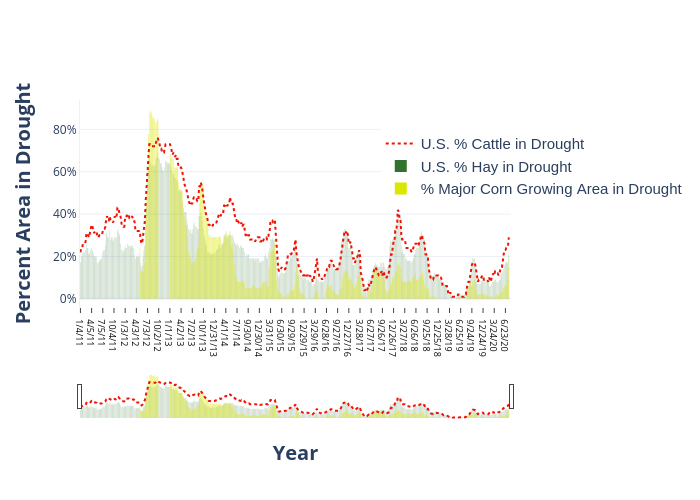Livestock Wx
Drought Trends for April 30, 2019: The Drought Dry Spell Marches On
[Excerpt from the April 30th U.S. Drought Monitor]
An active weather pattern maintained historically low drought coverage across the contiguous United States, with only a few areas currently experiencing dryness (D0) or moderate to severe drought (D1 to D2). Prior to April 2019, the record-low drought coverage across the Lower 48 States during the 20-year history of the U.S. Drought Monitor stood at 4.52% on May 23, 2017. During the drought-monitoring period ending on the morning of April 30, locally significant precipitation fell in dryness- and drought-affected areas across the Rockies, Intermountain West, northern Plains, and parts of the South. In contrast, little or no precipitation fell in the Far West and the southern Atlantic region.
The percentage of cattle, corn, and hay in drought continues to remain low at 1% cattle, 1% hay, and no corn areas considered in drought.
1% Cattle in Drought

1% Hay in Drought

Most recent (April 30th) U.S. Drought Monitor showing areas in Abnormally Dry (yellow) or Drought (orange). Counties in blue have 50K head of cattle or great, while counties in green produce 40K tons of hay or greater.
Interactive chart showing cattle, hay, and corn areas in drought since 2011. The data are ranked from highest to lowest in drought. Mouse over the chart to see individual years.
Potential Areas of Drought Improvement and Deterioration
The below images show the U.S. Drought Monitor from April 30th and the 15-Day Accumulated Precipitation, Temperature Anomaly and the 15-Day Potential Evapotranspiration Forecasts. Potential Evaportranspiration, or PET, is the amount of evaporation that would occur if sufficient water is available. Basically, you can think about it as the amount of water that could be evaporated from the soils and plants (if water was not limited, which is why it has “Potential” in the title).
The wet pattern will continue for Much of the Contiguous U.S. over the next 15 days. Evaporation rates will be highest over the Pacific Northwest and less intense in Far West and South Texas.
We should continue to see very minor drought for most of the U.S. We are watching, however, the OK Panhandle, Far West Texas down to South Texas and the Southeast U.S. For the Southeast, evaporation rates over the next 15 days are expected to be below normal and the accumulated rainfall over this time period should see them about break even. Therefore, we do not see a significant increase in drought over the next 15-days there.
April 23, 2019 U.S. Drought Monitor. Counties shaded in purple have cattle densities of 50K head or more.

15-Day Forecasts for precipitation (in.) and potential evapotranspiration (in.) The forecasts cover the period from May 2-May 16, 2019.
15-Day accumulated precipitation forecast (green/brown) and the Temperature Anomaly (orange/blue)compared to the 15-Day Potential Evapotranspiration Forecast (red/gray) for the period of May 2 – May 16. Use your mouse to see data for individual counties.
